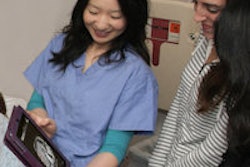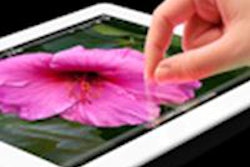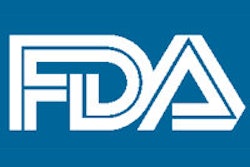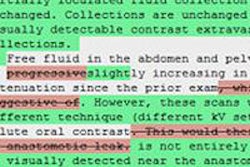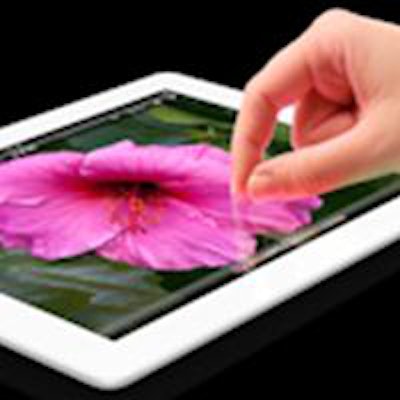
A free Apple iPad packed with four years of radiology residency content and connectivity is a hit -- shockingly -- among residents who use the device as their main learning tool throughout training, researchers report in the Journal of the American College of Radiology.
Users of the computer toolkit, developed at the University of Colorado in Aurora, cited a litany of happy side effects, including more efficient studying and better access to study materials, such as books, radiology cases, lectures, Web-based resources, and even content geared toward the new American Board of Radiology exam structure.
"The comprehensive and portable Radiology Resident iPad Toolbox has, and likely will continue to have, a hugely positive impact on the resident experience at the University of Colorado and represents a paradigm shift in resident education," wrote Dr. Emerson Sharpe III, Dr. Michael Kendrik, Dr. Colin Strickland, and Dr. Gerald Dodd (JACR, May 6, 2013).
Skipping the textbooks
Tablets and mobile computing have been a thing in radiology for a while now, of course. Several studies have looked at how tablets are affecting clinical practice and, particularly, the quality of medical image interpretation when imaging specialists use them on the run.
Still, the intended application for this study was a particularly tall order: The research team envisioned creating a single portable resource incorporating the totality of educational, clinical, and communication resources needed for a four-year radiology residency.
"This started with us trying to fortify our residents library, and the options were to buy a bunch of hardcover books and put them in a location that residents didn't go very frequently, and then figure out some difficult way to do checkout," said lead author and chief resident Sharpe in an interview with AuntMinnie.com.
Or, Sharpe thought, they might skip the textbooks altogether in favor of e-books, which were becoming more available for the iPad when the project began in late 2011.
After brainstorming with the department head and Sharpe's colleagues, the e-books idea grew into a 16-page business proposal for a far broader project aimed at putting the best possible online resources and communication technology into the hands of every resident -- and then finding ways to keep the content useful and up to date while encouraging learning, Sharpe said.
The result was a fully configured tablet loaded with carefully selected e-books, journals, radiology software, and communication apps that was distributed to each of 34 residents, a group evenly divided between first-, second-, third, and fourth-year trainees.
Loading the iPads
The hardware vehicle was the third-generation Apple iPad (32-GB Wi-Fi version). Radiology content was divided broadly into educational, clinical, and communication tools, Sharpe and colleagues wrote.
The group chose individual applications carefully, based on app searches and resident recommendations, rolling out the project in a limited fashion internally before the iPads were distributed to every resident in the department.
"We ended up with 20 to 30 different apps, and for radiology websites that don't have apps, we just created links on the iPad's front page, [and there was] an icon that made it easy for people to go into different folders," Sharpe said. "We had a communication folder, a conference folder, and one that links to all the radiology societies," for example.
To date, the team has purchased 18 e-books and a variety of other materials representing at least one title per subspecialty. Online retail giant Amazon had the greatest collection of e-books that were also compatible with its Kindle readers, so it provided much of the supply.
To build the program's resource lists, residents were surveyed to determine their idea of the most useful radiology books and other resources. Second-tier titles were added to a wish list, and over time, more titles are being purchased from this list, Sharpe said.
The toolkit also contains departmental lectures, articles, and other relevant files made available through the Dropbox and Blackboard file-sharing applications. The team bought a group license from the University of California, San Francisco for the RadPrimer series of 80 lectures, as well as 2,000 learning files from Radiology 2.0 and Radiopaedia applications.
The team purchased online access to various journals, including Radiology, American Journal of Roentgenology, Abdominal Imaging, Journal of Thoracic Imaging, and several other imaging mainstays. Some journal subscriptions took advantage of group discounts for department-wide access. The iPads include a link to AuntMinnie.com, he said, where the biggest draws remain Case of the Day and the Residents Forum.
Clinical tools include DICOM viewers, Amion hospital call schedule software, Radiology Assistant, and Citrix Receiver to enable remote access to the hospital.
Communication apps include the built-in camera and microphone for remote videoconferencing. WebEx Meetings allows residents to access didactic and case-conference lectures. With a student-response application called ResponseWare, residents can respond during lectures. Finally, email and instant message capabilities round out the communication package.
The 34 distributed iPads were all synced to a base computer station with a single user profile for all devices. Mobile device management software was set up to enable monitoring of content, remote control, and syncing.
The cost per device was $658 for hardware, $258 for e-books, $71 for media, and $258 for other electronic resources, for a total cost of $1,272 per device, the authors wrote. Purchased individually with all of the books and software, the iPads would have cost around $3,000.
"We saved over half per resident, and it's a huge matter of convenience, because we can carry a small 1-lb iPad around and have 18 books on it," Sharpe said. "You don't have to hunt down your books or carry two or three books that weigh up to 40 lb. You're so much more likely to use it and it's so much more portable ... it makes learning a lot more accessible for the residents."
The initial rollout to just four residents permitted critical commentary and changes before the broader introduction from July to December 2012. All devices were returned in perfect working condition before being handed back to their anxious caretakers to hold onto for another 3.5 years.
"We have a group meeting every week, and part of that meeting is ... making sure that all the apps are updated on that computer -- that if there are any new uploads, they've been done" in a process that syncs each device automatically with an Apple base station, Sharpe said.
Gauging utility
Sharpe and colleagues sent an email survey to gauge residents' usage patterns and opinions on the utility of the device: 100% responded. The survey asked about hours of usage, the most- and least-useful resources, whether the device facilitated access to educational materials, whether and how much it has improved studying efficiency, and whether residents would recommend it.
In all, 62% of residents used the device zero to five hours per week, and 38% used it six to 10 hours per week. One-fifth of residents reported greater use of electronic materials after introduction of the device, although one reported greater use of print materials.
Electronic textbooks had the greatest effect on resident radiology learning (82%), followed by anatomy atlases (12%) and online resources such StatDx (6%), a kind of radiology encyclopedia that helps rule out and rule in potential diagnoses. Conversely, access to journal articles and society guidelines (62%) had the least impact on resident training, according to the survey results.
Use of the device strengthened the quality of didactic lectures and facilitated the sharing of program information, the authors wrote. The audience-response software was seen as helping to boost attention paid to the material, while offering instantaneous feedback.
Audience-response and feedback capabilities have previously been shown to boost interest in didactic lectures, and iPads equipped for this task appeared to do the same, Sharpe said.
"That's one place where I think it's helped a lot, because now instead of everyone sitting there learning passively, there will be at least a couple of audience-response questions during the actual didactic lecture," Sharpe said.
As for new applications, residents are free to download their own radiology (or nonradiology) apps as they see fit, he said. If they're excited about a new app, they can even try to convince their colleagues through the forum process that the application should be included by default on future updates.
"We want it to be a living device, in a way, so that people are incentivized to go out there and find new things," Sharpe said.
The coordinated selection of educational, clinical, and communication resources represents a new degree of technology integration into radiology residency training, Sharpe and colleagues wrote. Active participation in the process by faculty and residents keeps the project fresh while continuing to enhance education, and the tablet makes it easier to find and use resources.
Residents are freed from having to spend time searching through boxes of documents and files, freed from having to ask the program coordinator to help them find things, and freed from lugging around textbooks, Sharpe said.
"All those things tie into increased usage and more study time and increased efficiency," he said. "Efficiency in residency is very valuable because you don't have a lot of time, and when you do, you want to be able to get what you need done quickly."




